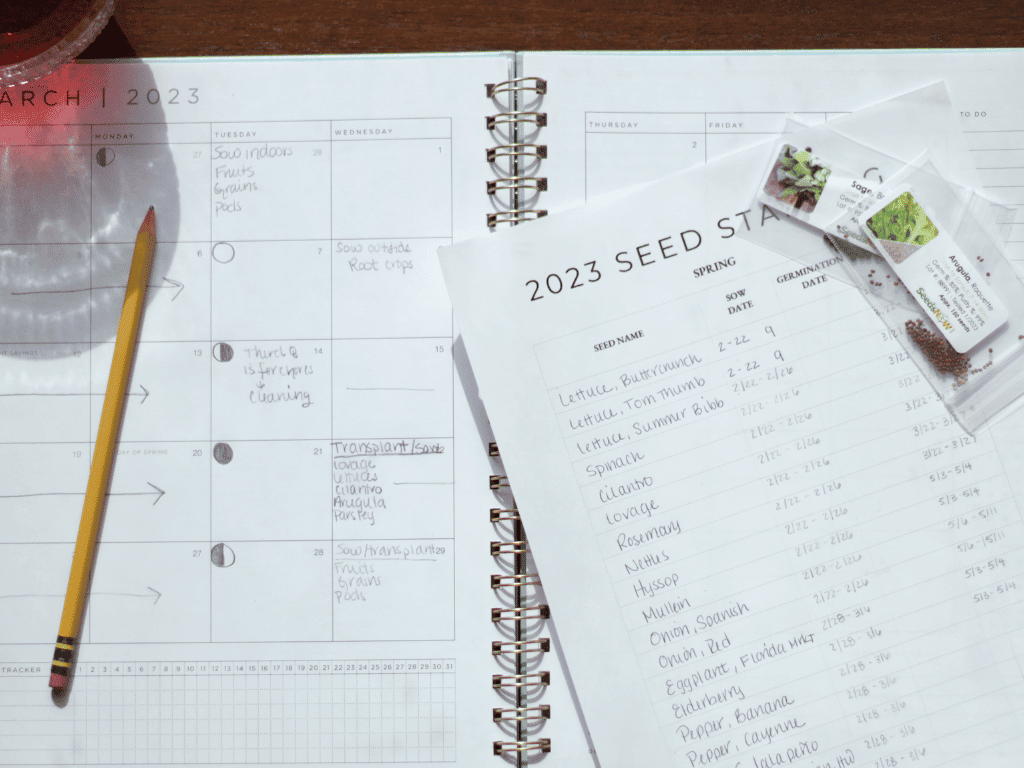Gardening by the Moon is a farming practice that uses the different moon phases as a guide for planting, harvesting, and other garden tasks. The Moon’s gravitational pull affects the moisture content in the soil, helping to promote seed germination or encourage deep root growth. Use this gardening by the moon cheat sheet to help schedule your monthly garden tasks.
The Different Moon Phases
Moon Phase: Moon phases are the different ways the moon appears to us based on the amount of sun light it is reflecting at that time. There are eight different phases: dark/new, waxing crescent, first quarter, waxing gibbous, full, waning gibbous, last quarter, and waning crescent.

New Moon: This is the beginning of of the new moon cycle. The light of the moon is growing (waxing). During this time, the lunar gravity pulls water up, helping seeds and seedlings have access to more water at the surface.
Waxing Crescent: The moon appears as a thin crescent, and the light continues to grow.
First Quarter: The moon appears as a half moon.
Waxing Gibbous: The moon light is covering more than half of the moon and continues to grow towards the full moon.
Full Moon: This occurs when the moon is completely illuminated.
Waning Gibbous: During the waning phase, the moon light decreases. Lunar gravity pulls water down into the soil helping roots to grow deeper.
Last Quarter: The moon appears as a half moon, and the light continues to decrease.
Waning Crescent: The moon appears as a thin crescent.
Above ground crops: These are plants that have parts harvested above the ground (tomatoes, lettuce, oats, mints, cucumbers, etc.).
Root Crops: The plant parts that exist below the surface, like roots and tubers (carrots, ginger, potatoes, burdock root, beets, etc.).
Garden bed: The area of soil cultivated for planting seeds or transplanting seedlings.
Seedlings: Young plants grown from seeds.
Transplanting: The action of uprooting and replanting a plant.

How to Garden by the Moon
In January or February, I mark down all the moon phases for the growing season in a calendar. I use these dates as a guide for starting seeds outdoors, transplanting, and harvesting.
Waxing Crescent
New Moon – First Quarter
Best time to sow or transplant leafy herbs and vegetables. Examples:
- Arugula
- Lettuce
- Spinach
- Cabbage
- Celery
- Mints
First Quarter
First Quarter – Full Moon
Best time to sow or transplant fruits and foods with external seeds. Examples:
- Tomatoes
- Peppers
- Eggplants
- Strawberries
- Broccoil
- Cauliflower
- Grains
Waning Gibbous
Full Moon – Last Quarter
Best time to plant root crops and fruit trees. Examples:
- Carrots
- Beets
- Potatoes
- Turnips
- Apple trees
- Elderberry
- Burdock
Last Quarter
Last Quarter – New Moon
During this time it is best to avoid planting, sowing, and transplanting. Instead, work on garden chores like fertilizing, adding soil amendments, weeding, and mulching.
Join Our Newsletter
Sign up for our monthly newsletter to get easy gardening tips, seasonal to-dos, and herbal recipes delivered right to your inbox.
Thank you!
Check your email to confirm your subscription.














